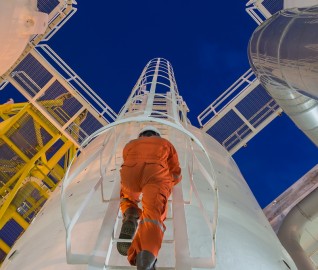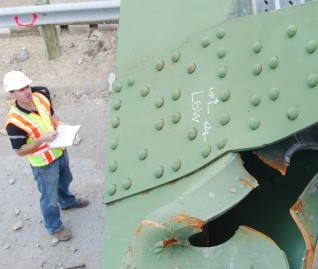WJE PROJECTS
Chemical Plant Unit


CLIENT |
Confidential |
LOCATION |
U.S. Gulf Coast |
Visual Assessment of Concrete Structures
WJE was retained by a major international chemical company to perform a visual assessment of the concrete structures in a chemical plant unit. The objective was to evaluate the condition of the concrete structures in the unit and develop prioritized recommendations for repairs, maintenance actions, and engineering controls for conditions identified during the assessment.
BACKGROUND
The subject process unit contained numerous types of conventionally reinforced concrete structures. The structures in the unit included square and circular columns supporting pipe racks and piping, equipment pedestals, block-type rotating equipment foundations, elevated tabletop structures, and walls for containment areas. The owner was aware of some distress conditions present in the unit but required assistance in understanding the cause of the deterioration and prioritizing repair and maintenance activities for the unit.
SOLUTION
WJE mobilized a team of structural engineers with experience in assessing concrete structures in process facilities to the site. We performed a visual assessment throughout the unit and performed acoustical sounding at selected locations to better understand the extent of deterioration.
We identified numerous locations of corrosion-related deterioration, including spalling with exposed and corroded reinforcing. The highest concentration of distress conditions occurred in an area of the unit that is consistently exposed to water vapor from cooling towers under prevailing winds. Due to the extent and severity of corrosion-related distress conditions in this portion of the unit and the presence of chlorides in the water vapor from the cooling towers, we determined that these distress conditions were likely caused by chloride-induced corrosion.
Upon completion of the assessment, we provided the client a detailed report which included a keynoted unit plot plan identifying distress conditions. We also provided a prioritized list of conceptual recommendations for repairs, maintenance actions, engineering controls, and additional investigative measures. The recommendations were organized into top-, medium-, and low-priority categories based on their structural significance.
RELATED INFORMATION
-
 Our metallurgical and applied mechanics engineers provide solutions related to design... MORE >Services | Metallurgy and Applied Mechanics
Our metallurgical and applied mechanics engineers provide solutions related to design... MORE >Services | Metallurgy and Applied Mechanics -
 When the integrity or condition of a structure is in question, clients rely on us for answers MORE >Services | Structural Engineering
When the integrity or condition of a structure is in question, clients rely on us for answers MORE >Services | Structural Engineering -
 We have pioneered the use of nondestructive evaluation methods—such as ground penetrating... MORE >Services | Nondestructive Evaluation
We have pioneered the use of nondestructive evaluation methods—such as ground penetrating... MORE >Services | Nondestructive Evaluation -
 We apply the lessons learned from more than 175,000 projects to provide clients with a full... MORE >Services | Condition Evaluation
We apply the lessons learned from more than 175,000 projects to provide clients with a full... MORE >Services | Condition Evaluation








































